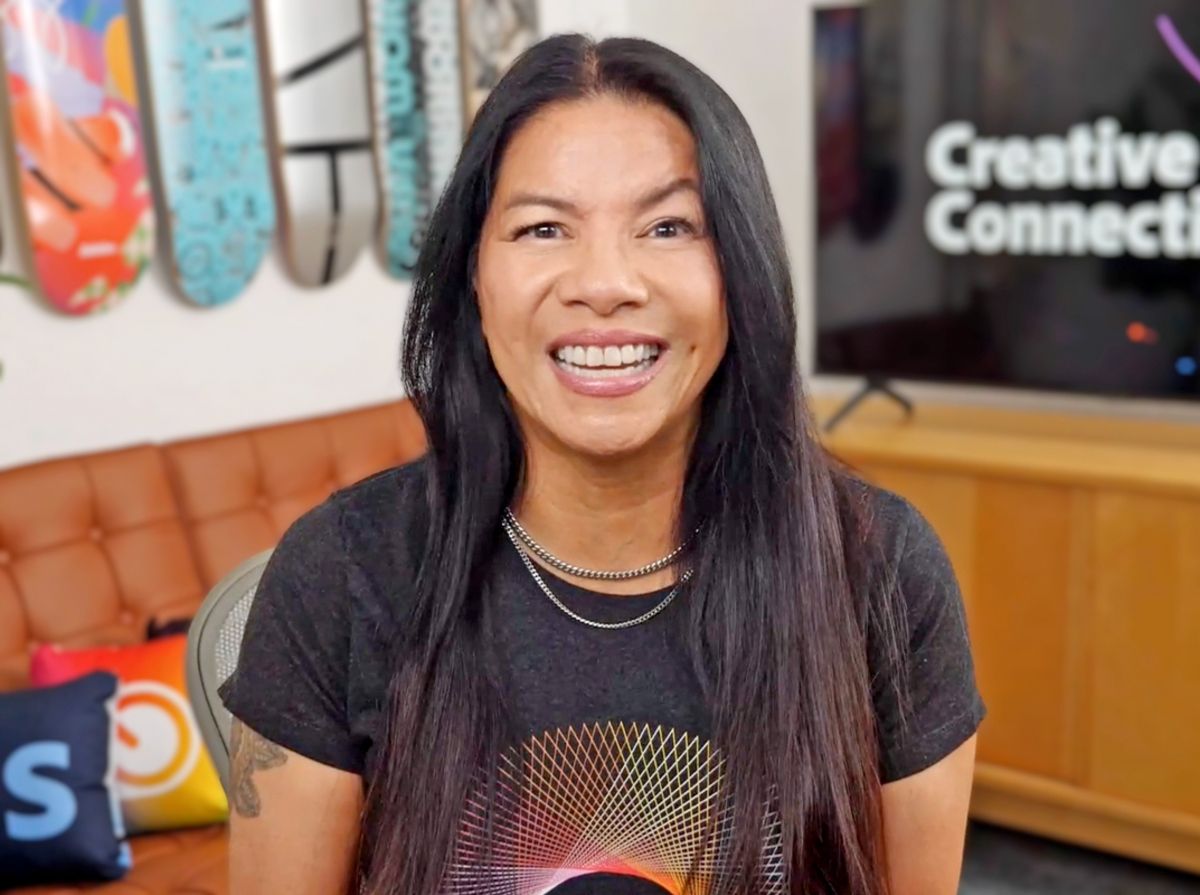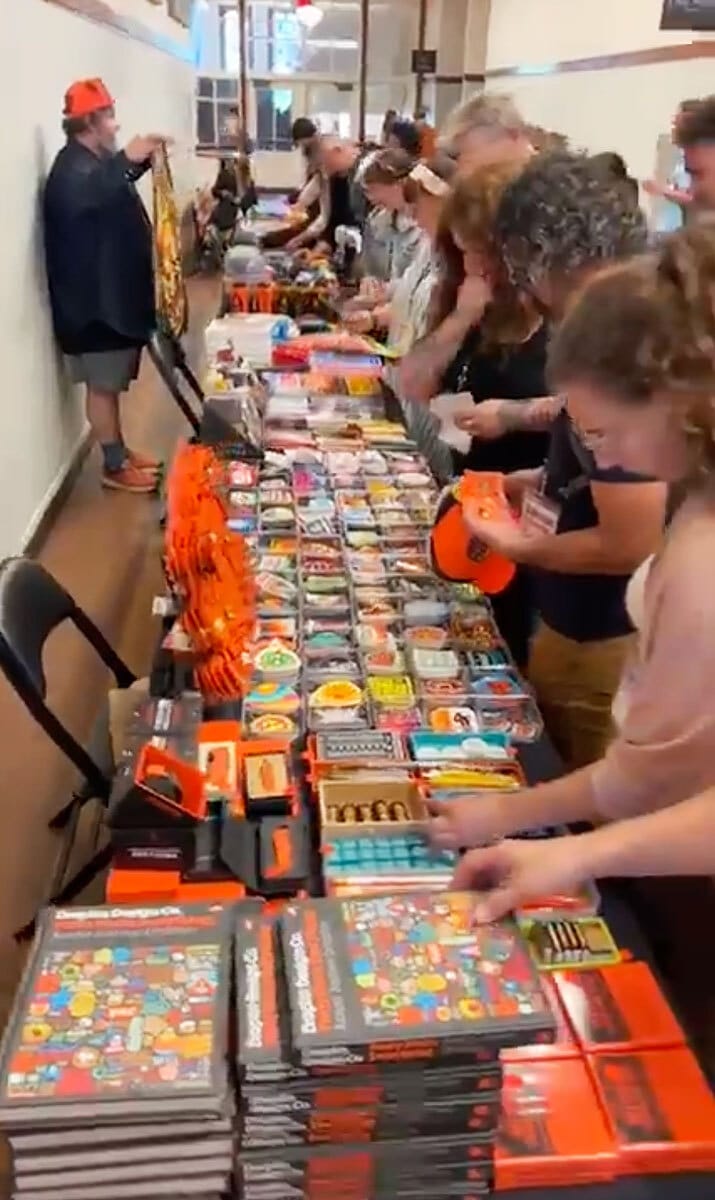A single letter can be beautiful, but without the others, it’s incomplete. Typography works because letters live in relationship with each other. The same is true for the people who create them.
Picture this: It’s 1 AM in the lobby of the Boston Park Plaza Hotel during TypeCon, and someone just drew the perfect ampersand. Not good. Not great. But perfect. Suddenly, strangers are huddled around a phone screen, debating stroke weight like it’s the meaning of life—that was summer 2017. These are my people.
After attending TypeCon 2025 in Portland (where I filmed Sam Berlow from The Type Founders wandering through the Future Fonts & Friends party like some kind of typographic David Attenborough), I’m reminded why the most powerful communities aren’t the biggest ones—they’re the ones where expertise gets passed hand-to-hand like family recipes, where decades of lived experience shape conversations over coffee.
The Living Commons of Type
TypeCon isn’t just another design conference where you collect business cards and pretend to remember names. It’s a living commons for the type world—where type designers, font foundries, lettering artists, calligraphers, and book designers bring their gloriously obsessive perspectives into the same room.
The magic happens between them. When a calligrapher and a font technologist start talking, you watch two entirely different worlds discover they share the same obsessions. When someone working in Arabic or Devanagari scripts explains their challenges, all the Latin-type designers suddenly realize how narrow their universe has been.
This is where real education happens. Not just in formal presentations, but in conversations that stretch through Revolution Hall’s century-old corridors—the same hallways where high school students once rushed between classes, now filled with designers sketching on napkins over shared meals.

Revolution Hall's century-old corridors, where high school students once rushed between classes

Gen Ramirez seen hand-lettering in the hallway
What Digital Can’t Replace
In an era where type design can be AI-assisted and distributed instantly, these in-person connections preserve the craft’s humanity. At TypeCon, expertise isn’t just consumed—it’s refined in real time. When Aaron James Draplin sets up what he calls “the longest merch table in Portland,” it’s not just about selling stuff. It’s about creating a physical space where conversations spark, where someone might discover their next favorite typeface… which might be Futura Bold, like Draplin.
The conference creates “productive friction,” those moments when different perspectives crash into each other and something new emerges. These aren’t just networking opportunities. They’re knowledge exchanges that can’t be replicated in Slack channels or Zoom calls, no matter how many font-related emoji you deploy.
The Power of Small Communities
Here’s what I’ve learned from years of building creative communities, including my own typography meetup “Los Angeles is Just My Type” (yes, that was the actual name, and yes, I’m still proud of that pun): niche communities like TypeCon are powerhouses precisely because they’re small enough to be personal yet deep enough to be world-changing. They nurture the next generation through mentorship that happens organically. They protect cultural heritage by keeping traditional techniques alive alongside digital innovation. They keep a centuries-old craft evolving by bringing together practitioners who might never cross paths otherwise.
When we celebrated 25 years of Positype and founder Neil Summerour at the TypeCon Spacebar Party, it wasn’t just about one foundry’s milestone. It was about recognizing the sustained commitment it takes to build something meaningful in this field—twenty-five years of relationships, of pushing the craft forward, of being part of a community that values both innovation and tradition.
Building Genuine Connections
The design world is surprisingly small, and the type world is even smaller. Today’s conference conversation partner might be tomorrow's collaborator, next month’s client, or the person who remembers you when you need that perfect recommendation.
What TypeCon does brilliantly is create conditions where relationships flourish naturally. The organizers understand something fundamental: you can’t force connections, but you can design experiences that make them inevitable. It’s like hosting the world’s most sophisticated dinner party, except instead of discussing politics, everyone’s passionately defending why their craft matters in ways most people never consider.
Beyond the Conference Walls
What strikes me most about TypeCon is how it extends beyond the conference walls. The collaborations that start over coffee in Portland continue in studios around the world. The problems discussed in sessions get solved in the months that follow, often by people who met in line for mini donuts. Someone’s casual comment about a technical challenge becomes another person’s breakthrough project, which becomes next year’s conference presentation.
This is community as strategy, not sentiment. After producing hundreds of virtual events and building communities from my Typography Dojo sessions to Adobe’s Creative Connections and Creative Jams series, I’ve learned that the most successful gatherings aren’t about perfect content, they’re about creating spaces where meaningful connections happen. TypeCon gets this right by balancing structured learning with unstructured mingling, serious craft discussion with the kind of typography jokes that make normal people back away slowly.
The Humanity in the Craft
TypeCon reminds us that letters—like people—only find their fullest meaning when they come together. Individual expertise is valuable, but it’s the connections between practitioners that keep the craft alive, evolving, and relevant.
In a world increasingly dominated by algorithmic recommendations and AI-generated content, there’s something profoundly human about gathering in person to talk about the shapes of letters, the history of scripts, the future of reading. These conversations matter because they’re about preserving the human element in communication itself.
Building Your Own Community
Here’s your permission slip: go find your people. Whether it’s TypeCon, AIGA events, Creative Mornings, or that random typography meetup in your city, show up. Bring your curiosity, your questions, and genuine intention to contribute.
And if you’re thinking about starting your own gathering? Do it. I’ve seen magic happen in conference rooms, coffee shops, and even that memorable AIGA LA art therapy session I hosted from my living room during the pandemic. The location doesn’t matter as much as the intention to serve your community.
The secret isn't in the scale, it's in the intention. Whether you’re organizing a local type meetup, hosting virtual design critiques, or creating industry-specific gatherings, the principles remain the same: give people a reason to show up, create space for genuine connection, and always prioritize community over content. Also, never underestimate the power of good coffee.
The design community needs more spaces where passionate people can connect, learn, and grow together. If you build it with genuine intention to serve your community, they will come. And they’ll probably bring friends who are just as obsessed with letterforms as you are.
The future of design isn’t just about mastering the latest software or keeping up with AI developments. It’s about building relationships with people who share your passion for making things beautiful, functional, and meaningful. It’s about preserving the human element in an increasingly digital world.
Because the design community doesn’t pause between events, it’s always on. Whether you’re attending TypeCon, hosting your own gatherings, or building connections one conversation at a time, remember that the magic happens in the spaces between us. Just like typography itself.

